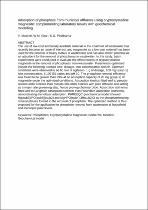 ResearchSpace
ResearchSpace
Adsorption of phosphate from municipal effluents using cryptocrystalline magnesite: complementing laboratory results with geochemical modelling
JavaScript is disabled for your browser. Some features of this site may not work without it.
- ResearchSpace
- →
- Research Publications/Outputs
- →
- Journal Articles
- →
- View Item
| dc.contributor.author |
Masindi, Vhahangwele

|
|
| dc.contributor.author |
Gitari, WM

|
|
| dc.contributor.author |
Pindihama, KG

|
|
| dc.date.accessioned | 2015-12-18T12:28:48Z | |
| dc.date.available | 2015-12-18T12:28:48Z | |
| dc.date.issued | 2015-11 | |
| dc.identifier.citation | Masindi, V, Gitari, WM and Pindihama, KG. 2015. Adsorption of phosphate from municipal effluents using cryptocrystalline magnesite: complementing laboratory results with geochemical modelling. In: Desalination and Water Treatment, 13pp. | en_US |
| dc.identifier.issn | 1944-3994 | |
| dc.identifier.uri | http://hdl.handle.net/10204/8320 | |
| dc.description | Abstract only. | en_US |
| dc.description.abstract | The use of low-cost and locally available material in the treatment of wastewater has recently become an issue of interest, and magnesite as a low-cost material has been used for the removal of heavy metals in wastewater and has also shown potential as an adsorbent for the removal of phosphates in wastewater. In this study, batch experiments were conducted to evaluate the effectiveness of cryptocrystalline magnesite in the removal of phosphates from wastewater. Parameters optimized include the following: contact time, dosage, ions concentration and pH. Optimum conditions were observed to be 60 min of agitation, 1 g of dosage, 100 mg L(sup-1) ions concentration, 1:100 S/L ratios and pH 10. The phosphate removal efficiency was found to be greater than 99% at an adsorption capacity of 20 mg g(sup-1) of magnesite under the optimized conditions. Adsorption kinetics fitted well to pseudo-second-order kinetics than pseudo-first-order kinetics with pore diffusion also acting as a major rate governing step, hence proving chemisorption. Adsorption isotherms fitted well to Langmuir adsorption isotherm than Freundlich adsorption isotherms, demonstrating monolayer adsorption. PHREEQC geochemical model showed Mg(sub3)(PO(sub4))(sub2) and MgHPO(sub4):3H(sub2)O as the phosphatebearing mineral phases formed in the removal of phosphate. The optimized method is thus proposed for the application for phosphate removal from wastewater at household and municipal plant levels. | en_US |
| dc.language.iso | en | en_US |
| dc.publisher | Taylor & Francis | en_US |
| dc.relation.ispartofseries | Worklist;15928 | |
| dc.subject | Phosphates | en_US |
| dc.subject | Cryptocrystalline magnesite | en_US |
| dc.subject | Isotherms | en_US |
| dc.subject | Kinetics | en_US |
| dc.subject | Geochemical models | en_US |
| dc.title | Adsorption of phosphate from municipal effluents using cryptocrystalline magnesite: complementing laboratory results with geochemical modelling | en_US |
| dc.type | Article | en_US |
| dc.identifier.apacitation | Masindi, V., Gitari, W., & Pindihama, K. (2015). Adsorption of phosphate from municipal effluents using cryptocrystalline magnesite: complementing laboratory results with geochemical modelling. http://hdl.handle.net/10204/8320 | en_ZA |
| dc.identifier.chicagocitation | Masindi, Vhahangwele, WM Gitari, and KG Pindihama "Adsorption of phosphate from municipal effluents using cryptocrystalline magnesite: complementing laboratory results with geochemical modelling." (2015) http://hdl.handle.net/10204/8320 | en_ZA |
| dc.identifier.vancouvercitation | Masindi V, Gitari W, Pindihama K. Adsorption of phosphate from municipal effluents using cryptocrystalline magnesite: complementing laboratory results with geochemical modelling. 2015; http://hdl.handle.net/10204/8320. | en_ZA |
| dc.identifier.ris | TY - Article AU - Masindi, Vhahangwele AU - Gitari, WM AU - Pindihama, KG AB - The use of low-cost and locally available material in the treatment of wastewater has recently become an issue of interest, and magnesite as a low-cost material has been used for the removal of heavy metals in wastewater and has also shown potential as an adsorbent for the removal of phosphates in wastewater. In this study, batch experiments were conducted to evaluate the effectiveness of cryptocrystalline magnesite in the removal of phosphates from wastewater. Parameters optimized include the following: contact time, dosage, ions concentration and pH. Optimum conditions were observed to be 60 min of agitation, 1 g of dosage, 100 mg L(sup-1) ions concentration, 1:100 S/L ratios and pH 10. The phosphate removal efficiency was found to be greater than 99% at an adsorption capacity of 20 mg g(sup-1) of magnesite under the optimized conditions. Adsorption kinetics fitted well to pseudo-second-order kinetics than pseudo-first-order kinetics with pore diffusion also acting as a major rate governing step, hence proving chemisorption. Adsorption isotherms fitted well to Langmuir adsorption isotherm than Freundlich adsorption isotherms, demonstrating monolayer adsorption. PHREEQC geochemical model showed Mg(sub3)(PO(sub4))(sub2) and MgHPO(sub4):3H(sub2)O as the phosphatebearing mineral phases formed in the removal of phosphate. The optimized method is thus proposed for the application for phosphate removal from wastewater at household and municipal plant levels. DA - 2015-11 DB - ResearchSpace DP - CSIR KW - Phosphates KW - Cryptocrystalline magnesite KW - Isotherms KW - Kinetics KW - Geochemical models LK - https://researchspace.csir.co.za PY - 2015 SM - 1944-3994 T1 - Adsorption of phosphate from municipal effluents using cryptocrystalline magnesite: complementing laboratory results with geochemical modelling TI - Adsorption of phosphate from municipal effluents using cryptocrystalline magnesite: complementing laboratory results with geochemical modelling UR - http://hdl.handle.net/10204/8320 ER - | en_ZA |





